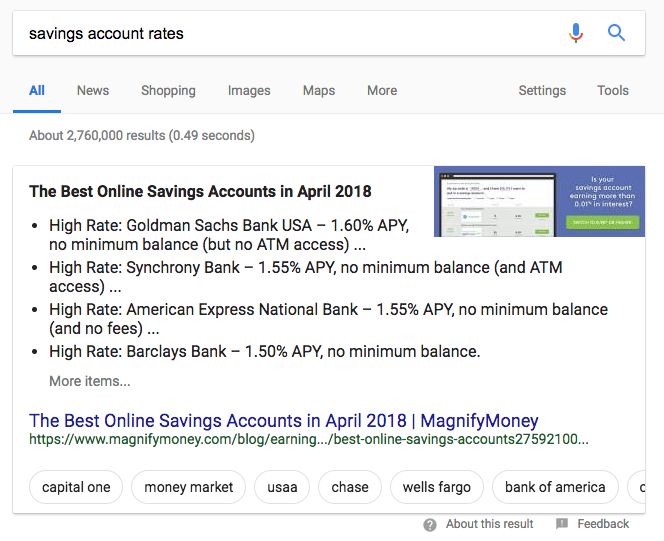There are now 6 times the number of snippets on a SERP Back in April, we sifted through every SERP in STAT to see just how large the initial carousel rollout was. Just remember: these new pages or competitors aren’t there to answer the original search query. Sometimes you’ll be able to expand your content in order to tackle those new topics and snag a bubble snippet, and sometimes they’ll be beyond your reach. With bubble snippets, only 36.58 percent of their URLs came from the top 10 ranks. We think this is due to relevancy: Because bubble snippet queries only relate to the original search term — they’re not attempting to answer it directly — it makes sense that their organic URLs wouldn’t rank particularly high on the SERP. "Search for" links don't tend to surface the same snippet on the new SERP Since bubble snippets are technically providing answers to questions different from the original search term, we looked into what shows up when the bubble query is the keyword being searched. Specifically, we wanted to see if, when we click the “Search for” link in a bubble snippet, the subsequent SERP 1) had a featured snippet and 2) had a featured snippet that matched the bubble snippet from whence it came. The answers to our two pressing questions were thus: Strange, but true, even though the bubble query was snippet-worthy on the first, related SERP, it wasn’t always snippet-worthy on its own SERP. Stranger still, 78.11 percent of the time, the bubble snippet and its snippet on the subsequent SERP weren’t a match — Google surfaced two different answers for the same question. 32.21 percent of our carousel snippets did return bubbles with one format, but 59.71 percent had two and 8.09 percent had all three.
Google let it be known earlier this year that snippets were a-changin’. And true to their word, we’ve seen them make two major updates to the feature — all in an attempt to answer more of your questions.
We first took you on a deep dive of double featured snippets, and now we’re taking you for a ride on the carousel snippet. We’ll explore how it behaves in the wild and which of its snippets you can win.
For your safety, please remain seated and keep your hands, arms, feet, and legs inside the vehicle at all times!
What a carousel snippet is an how it works
This particular snippet holds the answers to many different questions and, as the name suggests, employs carousel-like behaviour in order to surface them all.

When you click one of the “IQ-bubbles” that run along the bottom of the snippet, JavaScript takes over and replaces the initial “parent” snippet with one that answers a brand new query. This query is a combination of your original search term and the text of the IQ-bubble.
So, if you searched [savings account rates] and clicked the “capital one” IQ-bubble, you’d be looking at a snippet for “savings account rates capital one.” That said, 72.06 percent of the time, natural language processing will step in here and produce something more sensible, like “capital one savings account rates.”

On the new snippet, the IQ-bubbles sit at the top, making room for the “Search for” link at the bottom. The link is the bubble snippet’s query and, when clicked, becomes the search query of a whole new SERP — a bit of fun borrowed from the “People also ask” box.
You can blame the ludicrous “IQ-bubble” name on Google — it’s the class tag they gave on HTML SERP. We have heard them referred to as “refinement” bubbles or “related search” bubbles, but we don’t like either because we’ve seen them do both refine and relate. IQ-bubble it is.
There are now 6 times the number of snippets on a SERP
Back in April, we sifted through every SERP in STAT to see just how large the initial carousel rollout was. Turns out, it made a decent-sized first impression.
Appearing only in America, we discovered 40,977 desktop and mobile SERPs with carousel snippets, which makes up a hair over 9 percent of the US-en market. When we peeked again at the beginning of August, carousel snippets had grown by half but still had yet to reach non-US markets.

Since one IQ-bubble equals one snippet, we deemed it essential to count every single bubble we saw. All told, there were a dizzying 224,508 IQ-bubbles on our SERPs. This means that 41,000 keywords managed to produce over 220,000 extra featured snippets. We’ll give you a minute to pick your jaw up off the floor.
The lowest and most common number of bubbles we saw on a carousel snippet was three, and the highest was 10. The average number of bubbles per carousel snippet was 5.48 — an IQ of five if you round to the nearest whole bubble (they’re not that smart).
Depending on whether you’re a glass-half-full or a glass-half-empty kind of person, this either makes for a lot of opportunity or a lot of competition, right at the top of the SERP.
Most bubble-snippet URLs are nowhere else on the SERP
When we’ve looked at “normal” snippets in the past, we’ve always been able to find the organic results that they’ve been sourced from. This wasn’t the case with carousel snippets — we could only find 10.76 percent of IQ-bubble URLs on the 100-result SERP. This left 89.24 percent unaccounted for, which is a metric heck-tonne of new results to contend with.
Concerned about the potential competitor implications…

COMMENTS